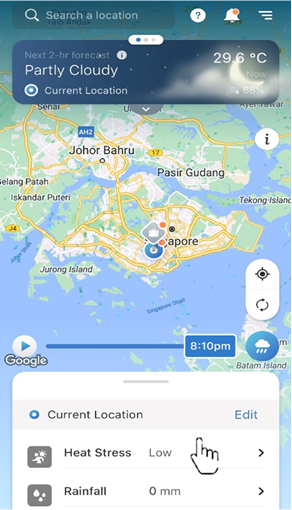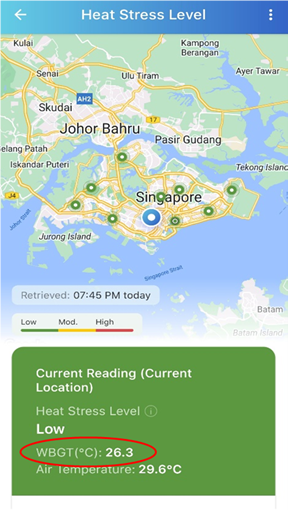Heat stress occurs when our body is not able to cool itself sufficiently, and excess heat builds up, which may cause damage to the body. When the body produces and retains more heat than it loses, one may exhibit signs and symptoms related to heat stress.
Heat stroke is the most serious type of heat-related illness and can result in death.
Early signs and symptoms of heat injury may include weakness, dizziness, visual disturbances, intense thirst, nausea, headache, vomiting, diarrhoea, muscle cramps, breathlessness, palpitations, tingling and numbness of the hands and feet. These symptoms may, if not identified and the individual not treated appropriately, progress to heat stroke.
Heat stroke is the most serious type of heat-related illness. Signs of heat stroke include a body core temperature that is often, but not always, greater than 40 degrees Celsius, with complete or partial loss of consciousness, disorientation, and seizures.
For more information, you may refer to the Workplace Safety and Health Guidelines on Managing Heat Stress in the Workplace.
If the worker is drowsy or unconscious, call 995 for emergency medical attention. If the worker is still alert and conscious, they should be moved to a cool, shaded, well-ventilated area and given cold fluids. Excess clothing should be removed, and ice packs, cold water and wet towels can be applied to help cool them down.
For more information, you may refer to the Workplace Safety and Health Guidelines on Managing Heat Stress in the Workplace.
Under the Workplace Safety and Health (Incident Reporting) Regulations, employers and medical practitioners are required to report occupational diseases (ODs) caused by excessive heat, to MOM through WSH Incident Reporting.
Under the Work Injury Compensation Act (WICA), an employee who sustains an illness or injury arising out of and in the course of employment is eligible to claim work injury compensation from his employer.
Workplaces can refer to the Workplace Safety and Health Guidelines on Managing Heat Stress in the Workplace published by the Workplace Safety and Health Council for more information. The WSH guidelines complements the advisory on Heat Stress Measures for Outdoor Work.
Workers with personal risk factors such as unacclimatised to working in hot environment, chronic diseases, medication use, history of heat injury or pregnancy are more vulnerable to heat stress.
For more information, you may refer to the Workplace Safety and Health Guidelines on Managing Heat Stress in the Workplace.
The following groups of workers need to undergo acclimatisation:
- Newly assigned to outdoor work
- New or returning from countries with a cold climate
- Returning from long leave of more than 1 week
- Recovering from prolonged illness
Workers should be acclimatised gradually by increasing the number of hours they spend in the hot environment and taking frequent rest and water breaks. This helps the worker adapt to the hot environment and improve their heat tolerance.
For more information, you may refer to the Workplace Safety and Health Guidelines on Managing Heat Stress in the Workplace.
Workplaces should assess the heat stress risk and implement a heat stress management programme to mitigate the risk of heat-related illnesses at the workplace.
As heat strain experienced by individual workers is multi-factorial, layering on different heat stress measures provides more protection for workers – acclimatise, drink, rest and shade. Workplaces can refer to the Heat Stress Management Compliance Checklist published on WSH Council’s website.
Rest areas provided at the work site should be close to the work areas where feasible. This will enable workers to take their rest breaks without walking long distances to reach their rest area.
Hot processes (e.g. welding, cooking processes) or heat sources (e.g. generators, electrical equipment) present at the workplace can pose heat stress risks indoors.
Refer to Workplace Safety and Health Guidelines on Managing Heat Stress in the Workplace for more information on indoor work with heat stress risk.
No, the rest duration should be continuous and not broken into shorter durations. It is important for workers to be given proper rest under shade to allow adequate time for cooling down and reducing the heat load on their bodies.
When carrying out heavy physical work at WBGT(°C) 32 and above, a minimum rest break of 10 minutes is required every hour. At higher WBGT measurements, longer rest breaks every hour are recommended.
No, the hourly rest break should be adhered to. This is to prevent cumulation of heat buildup in the body.
Yes, the rest breaks should be considered paid working hours as workers may continue to take direction from employers during this period. The rest break is necessary to minimise the risk of heat injuries for the outdoor work carried out.
No, if workers are already given tea break for a particular hour of work, you do not need to provide additional paid rest break to mitigate heat stress.
Worker should first raise their concerns to their supervisor, HR department and union representatives. If no action has been taken, workers may contact MOM.
If there are significant safety and health concerns regarding heat stress risk for outdoor work, workers can submit their concerns via MOM’s SnapSAFE feedback channel.
Under the Workplace Safety and Health Act (WSHA), employers and occupiers have duties to ensure that workplaces are safe and without risks to the health of every person within the premises, and to protect the safety and health of every employee. This will include minimising the risk of heat injuries among workers.
Failure to do so may result in enforcement actions by MOM under the WSH Act, including stop work orders and composition fines.
The Wet Bulb Globe Temperature (WBGT) is an internationally recognised measurement that reflects the main environmental factors contributing to heat stress. Besides air temperature, WBGT is also affected by humidity, wind speed, and solar radiation.
The risk of heat stress at the workplace can be assessed by measuring the Wet Bulb Globe Temperature (WBGT), using portable or handheld meter or the WBGT reading from the National Environment Agency’s myENV app.
WBGT should be measured hourly especially during the hotter hours of the day to determine heat stress risk levels so that timely actions can be taken to protect workers.
For more information on WBGT monitoring, you may refer to the Guidelines on WBGT monitoring for outdoor work.
The WBGT figures on the myENV app can be accessed through the following steps:
Step 1: Click on the “Heat Stress” icon on the home page

Step 2: Read the WBGT values (circled)

Is it mandatory for me to have a meter to measure WBGT at my workplace?Show
We will require construction sites (with contract sums of $5 million or more), shipyards and the process industry, to have a WBGT meter on-site for localised measurements. These sectors are more likely to have prolonged outdoor work activities and workers may face a higher risk of heat stress.
The remaining workplaces are more likely to have intermittent outdoor exposure activities and can refer to myENV app’s WBGT readings.
Outdoor WBGT should be monitored at locations representative of heat stress risk levels at the workplace. The WBGT meter should be placed under direct sun exposure and not blocked by buildings or shade. The WBGT meter should be placed at around 1 metre above the ground to allow WBGT readings to stabilise in the work environment before measurements are taken. The duration for stabilisation should follow manufacturer’s recommendation or a minimum of 10 minutes.
There should be at least one point of outdoor WBGT monitoring conducted at the workplace. For larger workplaces, multiple points of measures are recommended.
You may refer to the poster on Manage and Monitor Heat Stress at Workplace.
Anyone who is familiar with the operation of the WBGT meter can take WBGT measurements at the workplace.
Workplaces are required to monitor WBGT at the workplace to assess heat stress risks.
WBGT meters used at workplaces should meet these specifications:
| Measurement parameters of WBGT meter |
Range |
Resolution |
Accuracy |
|
WBGT (Outdoor)
WBGT (Indoor)
|
10 - 50°C |
0.1°C |
± 2°C |
| Natural wet bulb temperature |
10 - 50°C |
0.1°C |
± 1°C |
| Globe temperature |
10 - 60°C |
0.1°C |
± 2°C |
| Dry air/ambient temperature |
10 - 50°C |
0.1°C |
± 1°C |
Note: The range, resolution and accuracy in the table applies to both measured and calculated parameters.
All meters must be calibrated annually or according to manufacturer’s specifications.
You can also download the specifications for WBGT meters for workplace measurement on Workplace Safety and Health Council’s website.
All meters must be calibrated in accordance with manufacturer’s specifications. If the manufacturer did not specify any frequency, the meters must be calibrated annually.
The WBGT meter may be calibrated by suppliers authorised by the manufacturer or Singapore Accreditation Council (SAC)-accredited laboratories. A list of local service providers offering calibration service for WBGT meters is available for download.
The minimum requirements for calibration are:
| Parameter |
Calibration Points |
Accuracy |
| Dry bulb temperature |
50 °C |
± 1°C |
| Humidity |
33% and 75% |
± 5% |
| Globe temperature |
50 °C |
± 2°C |